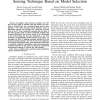Free Online Productivity Tools
i2Speak
i2Symbol
i2OCR
iTex2Img
iWeb2Print
iWeb2Shot
i2Type
iPdf2Split
iPdf2Merge
i2Bopomofo
i2Arabic
i2Style
i2Image
i2PDF
iLatex2Rtf
Sci2ools
ICUMT
2009
2009
Application of smoothed estimators in spectrum sensing technique based on model selection
In cognitive radio networks, secondary user (SU) does not have rights to transmit when the primary user (PU) band is occupied, that's why a sensing technique must be done. Recently, a new blind spectrum sensing technique based on distribution analysis was developed for sensing the spectrum holes in the PU band. Specifically, assuming that the noise of the radio spectrum band can still be adequately modeled using Gaussian distribution, this detector decide if the distribution of the received signal fits the noise distribution or not. This technique is computationally simple and fast. In this paper1 , we investigate the effect of applying smoothed estimators for this spectrum sensing technique. We will show that the application of smoothed periodograms offers good performances and keeps a reasonable complexity. Simulations results and performances evaluation presented in this paper are based on experimental measurements captured by Eur
| Added | 19 Feb 2011 |
| Updated | 19 Feb 2011 |
| Type | Journal |
| Year | 2009 |
| Where | ICUMT |
| Authors | Bassem Zayen, Aawatif Hayar, Hamza Debbabi, Hichem Besbes |
Comments (0)

